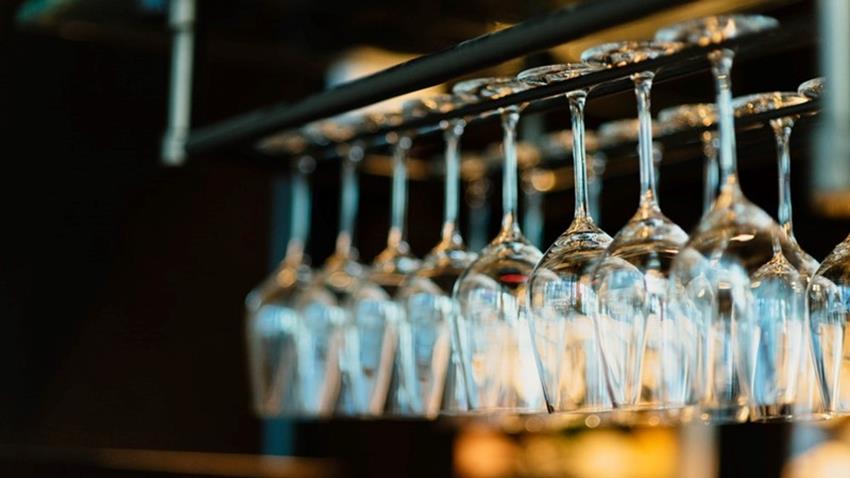
Wine can be a hugely profitable category for your venue if done right; it’s the most obvious drink to choose with a meal, a well prepared wine list can do the selling for you, and it takes up less service time to pour a glass of wine than make a G&T. Still, we see a number of outlets with staff that are intimidated about talking about wine and place little emphasis on the category as a whole. But, being more vocal about your wine offer will put more money in the till. Here are five ways that we believe licensees can sell more wine, and importantly, more good wine!
Wine tasting events
We love a good wine evening! Who can blame us? A selection of dishes, with each course paired with a glass of wine. These evenings, run as either a one-off event or a regular date in the dairy, are a great opportunity to attract regular wine drinkers and show them you’re serious about your range. A number of our customers run wine evenings on a quarterly basis to match the seasons and get feedback on their new menu and the wine selection.
Beyond the wine connoisseurs, inviting your regulars along to a wine evening gives them a reason to venture out and a reason to keep coming back time and time again. It doesn’t have to be a full 5-course menu either, port and cheese nights are always a winner! The key is to get your customers, and potential customers, talking about good wine and your venue. You can have as few or many wines as you like. Your Matthew Clark account manager will be able to suggest and some wines and potential pairings for you.
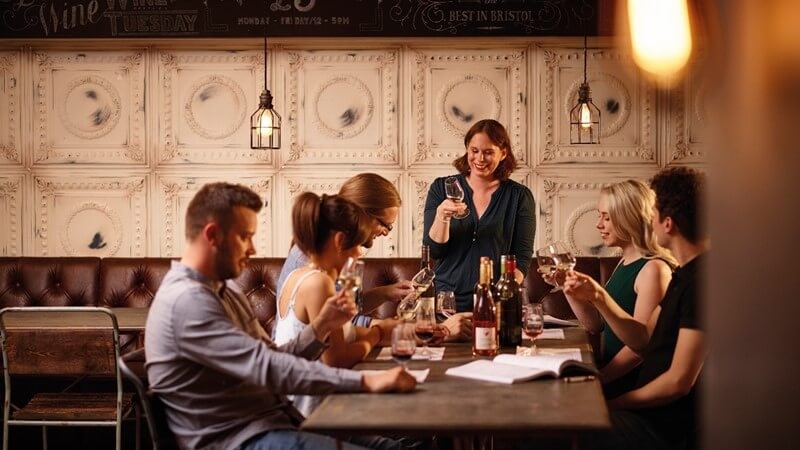
Arranging by style
Research points to consumers preferring a wine list to be arranged by style. The research by the late Gérard Basset MW found customers want lists arranged by either type, taste or by food matching and felt that a list laid out geographically ‘indicated that the restaurant knew the least about wine’. Our Wine Expression classification system is an easy way to arrange your list in the way customers want to see it.
Wine Expression groups together similar wines. Customers always look for a risk-free purchase, but they will experiment if they are given some confidence they will like their choice; this has key commercial advantages. Wine revenues increase as customers focus first on how the wine tastes before price. Customers spend on a better wine as more of the list is now accessible to the consumer, not just the entry-level wines.
Progressive Pricing
Many outlets will apply a fixed GP (gross profit) margin across the entire wine list, this has the disadvantage of ramping up the sale price of better wines to the point that sales of these wines are considerably reduced. Many consumers don’t venture up the price ladder too high and have a ceiling price they are prepared to pay. The result is they stick around the bottom of the list.
Applying a fixed cash margin amount for a bottle regardless of price across the entire range addresses this but inflates the prices at the bottom of your list too much. We believe the best approach is a third way, a progressive pricing structure where the pricing ladder rungs are closer together and more top wines fall within the budget of more consumers. Yet, the outlet makes more cash when better and more expensive wines are enjoyed by customers.
Example
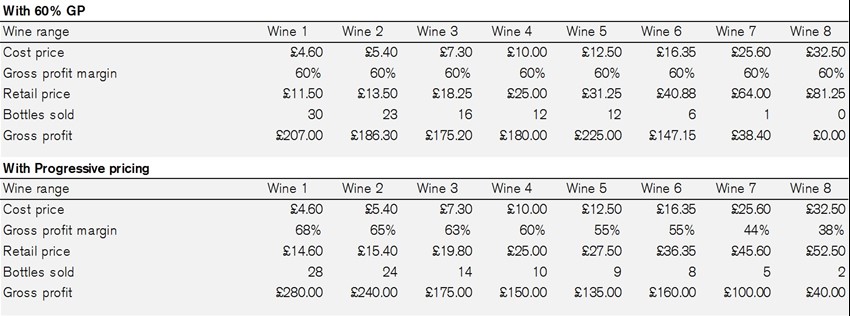
In this example, when a 60% fixed GP margin is applied across the wine list very few wines 7 and 8 are sold. For the 100 bottles sold the total gross profit is £1,159.05. With a progressive pricing approach, sales are further spread across the range. The total cost of sales increases and the average GP margin drops to 56%, however, the total gross profit is £1,280.00, making this outlet an average of £1.20 per bottle more.
Getting customers to explore
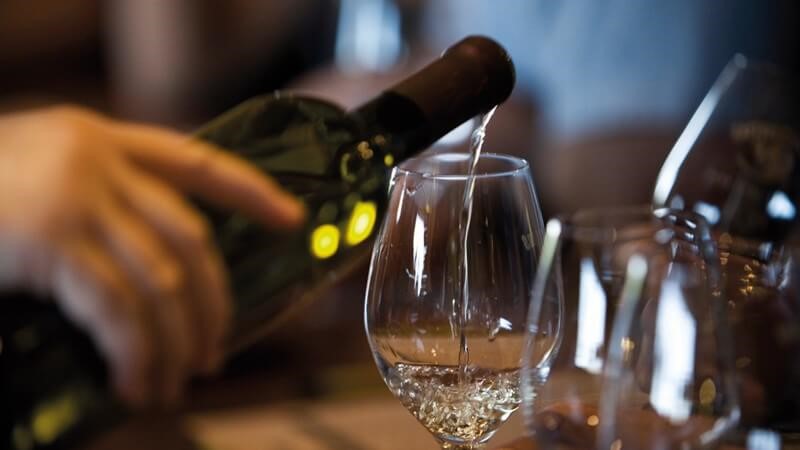
46% of consumers enjoy trying new and different styles of wine on a regular basis. Always look to find out what the customer is looking for and recommend a relevant wine. Focus on the benefit to the customer, why should they spend more? For a customer that enjoys a dry white, you may say something like, “would you like to try the Albarino, it will go great with your fish?”
Although it’s often done with real ale, few venues offer customers the chance to ‘try before you buy’ with wine. We think this is a missed opportunity. Offer customers a 25ml red or white sample either when seated for food or looking at the wine list at the bar. Inform them that it’s new in or a wine for the season and follow it up with “What do you think? Shall I get you a glass?”
Savvy operators are offering more wines by the glass, making aspirational wines more accessible. Many consumers worry about trying new wines in the on-trade due to the risk that they will be stuck with a bottle they don’t like. This risk is greatly reduced with the cost of a glass thus allowing them to venture further up the wine list. Preservation systems such as those by Bermar or Coravin helps to reduce the risk to you of any wastage.
Getting the right range
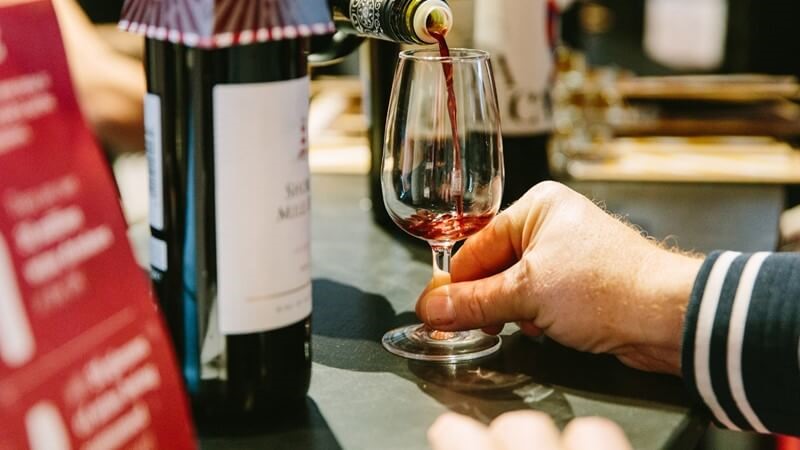
Choose wines that appeal to the outlet’s customers; recognising the needs of different wine drinkers. Younger inexperienced customers will look for famous grapes from popular countries; whilst more knowledgeable customers may prefer something different from the mainstream. Consider the popularity of wines from different countries and reflect this on the list. France, Italy and Australia are the top performers in the on-trade; the USA, Chile and South Africa come next; followed by Spain, Argentina and New Zealand.
Wines made from the leading grape varieties should definitely be featured, but not necessarily at the entry level. These ‘international’ varieties, think Chardonnay and Merlot, are well known and their fans will trade up a little to access them. Alongside the classics, offer wines for more adventurous drinkers, wines that will make customers follow you up the pricing ladder and away from the wines that demand smaller margins. Think of offering a fashionable Malbec in place of a Cabernet Sauvignon or an Albarino in place of a Sauvignon Blanc.
If you’re unsure about revamping your range for Christmas, consider just adding two or three guest wines to promote to customers. Focus on indulgent reds at this time of year; with customers willing to spend more at Christmas, adding a premium French guest wine to your list could well pay off. France is by far the favourite for consumers looking to buy wine at special occasions.


